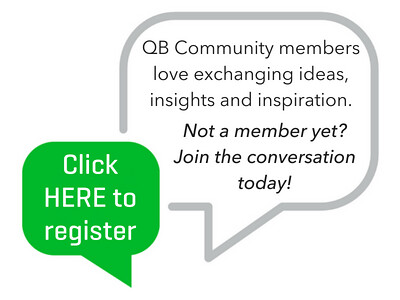- Mark as New
- Bookmark
- Subscribe
- Highlight
- Report Inappropriate Content
Shifting Your Business Into the Future of Commerce
Was there life before smartphones? Mine certainly wasn’t as flexible. Smartphones have brought many of us the freedom we wanted to be able to attend to life and our business -- whenever and wherever.
In fact, the entire way we do business has changed so much in the last decade. And it’s only speeding up. Car phones, faxing, phone book ads and catalogue shopping have all been left in innovation’s dust, while entire industries such as hospitality, retail, entertainment and publishing have been disrupted by better, faster and stronger technologies. What did I do before Instacart?
This May, in QB Community, we’ll be exploring these “Business Shifts” and what they mean for you, the small business owner. Expect great discussions on shifting from analogue to digital, paper to cloud, brick-and-mortar to e-commerce, cash to smart pay, “real’ people to bots, even dining out to delivery.
Here are three big changes that can impact you as the future of commerce continues to grow. First, the way that consumers want to shop is changing -- and it’s not all online like you may think. Secondly, customer expectations are sky-high when it comes to instant availability and fast shipping. And third, with technology providing easy access to so many different businesses, customer loyalties can easily shift if they aren’t being provided with the experience they desire.
Shift #1: Customers want to shop online and in-store
By 2019, it’s predicted that at least 45% of an organization’s revenue will be tied to their current (as in, now) digital transformation. What’s that mean for you? Well, it means that upgrading today will pay off tomorrow as consumers become more accustomed to shopping by voice, paying with their smartphones, receiving customized products (think personally tailored jeans) and “showrooming” -- checking out a product in-store first before finding the best deal online.
Yes, shoppers still frequent the brick-and-mortar shops. In fact, 87% of shoppers say they’ve visited a retail store in the past month, but they’re not just randomly browsing when they get there -- the majority have already researched online what they plan to buy.
Shift #2: Customers want it here (and there) and they want it now
With a giant selection of products available at our fingertips, often the decision of where to purchase comes down to how fast a retailer can get it to you -- either through lightning-fast shipping or in-store pickup. Today’s shoppers demand a seamless shopping experience no matter the channel, transitioning from smartphone to laptop to brick-and-mortar without effort.
No matter the generation, Baby Boomer, Gen X or Millennial, almost 90% say that having real-time access to the products they want influences where they shop. That means integrating store and online inventories, providing assistance 24/7, maintaining an updated database and keeping all lines of communication easy and open.
Shift #3: So many options means shifting customer loyalty
If there’s a downside to the future of commerce it’s that loyalties are easier to shift. 70% of shoppers say that the increase in digital access to businesses makes it easier for them to go elsewhere when their needs aren’t being met. So while transforming your business digitally both internally and client-facing is keeping up with the times, don’t forgo excellent and personal customer service.
When it comes to customer experience, 98% of online shoppers said they prefer interacting with a human rather than a bot, yet only 62% could tell if they were actually having an exchange with a real person or with a bot. Technology is getting smarter, but it won’t replace the human passion you bring to your business -- that’s something customers will never mistake.
The good news for small business owners and the self-employed is that, well, you’re small, and this means you’re nimble and can adapt more rapidly to a new digital business age. Take advantage of the cost- and time-saving tools while maintaining the humanity. It’s all about finding the right balance as you shift.
Warmly,
Leslie


